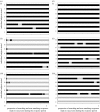Observational learning in chimpanzees and children studied through 'ghost' conditions
- PMID: 18182368
- PMCID: PMC2596905
- DOI: 10.1098/rspb.2007.1542
Observational learning in chimpanzees and children studied through 'ghost' conditions
Abstract
Emulation has been distinguished from imitation as a form of observational learning because it focuses not on the model's actions but on the action's environmental results. Whether a species emulates, imitates or displays only simpler observational learning is expected to have profound implications for its capacity for cultural transmission. Chimpanzees' observational learning has been suggested to be primarily emulative, but this is an inference largely based upon low fidelity copying in experiments when comparing chimpanzees with humans rather than direct testing. Here we test directly for emulation learning by chimpanzees and children using a 'ghost' condition in which a sliding door obscuring a reward was moved to left or right with no agent visible, a context associated with the only published evidence for emulation learning in a non-human species (pigeons). Both children and chimpanzees matched the observed direction of ghost door movement on their first test trial. This is the first evidence for emulation in a non-human primate in the restricted context of a ghost condition. However, only the children continued to match in later trials. Individuals of both species continued to match with 99% or better fidelity when viewing a conspecific model operates the door. We conclude that chimpanzees can and will display emulation learning when the task is as simple as the present one, which contrasts with a failure to do so in a more complex manipulative task tested earlier. However, even with a simple task, emulation alone creates only fleeting fidelity compared with the opportunity to copy a conspecific, when considerable conformity is displayed.
Figures



References
-
- Akins C.K, Klein E.D, Zentall T.R. Imitative learning in Japanese quail (Coturnix japonica) using the bidirectional control procedure. Anim. Learn. Behav. 2002;30:275–281. - PubMed
-
- Byrne R.W. Emulation in apes: verdict ‘not proven’. Dev. Sci. 2002;5:20–22. doi:10.1111/1467-7687.00198 - DOI
-
- Call J, Carpenter M, Tomasello M. Copying results and copying actions in the process of social learning: chimpanzees (Pan troglodytes) and human children (Homo sapiens) Anim. Cogn. 2005;8:151–163. doi:10.1007/s10071-004-0237-8 - DOI - PubMed
-
- Fawcett T.W, Skinner A.M.J, Goldsmith A.R. A test of imitative learning in starlings using a two-action method with an enhanced ghost control. Anim. Behav. 2002;64:547–556. doi:10.1006/anbe.2002.3092 - DOI
-
- Fragaszy D, Perry S. Cambridge University Press; Cambridge, UK: 2003. The biology of traditions: models and evidence.
MeSH terms
Grants and funding
LinkOut - more resources
Full Text Sources
Molecular Biology Databases

